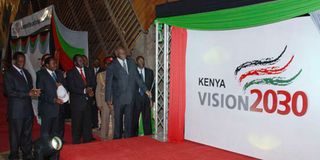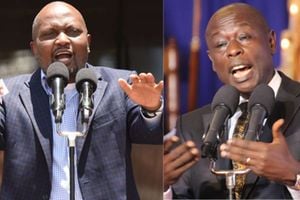How he did it: Reflections of a minister in the Kibaki government

President Mwai Kibaki (right) with Prime Minister Raila Odinga (third left), vice-president Kalonzo Musyoka (second left) and Planning minister Wycliffe Oparanya when they unveiled the Vision 2030 logo at KICC, Nairobi, in 2008.
What you need to know:
- Kibaki was driven by a sense that economic development and laying the foundation for future prosperity of the country was his principle calling.
- Kibaki ran government with a combination of confidence in his team and a rare readiness to entrust lieutenants with decision-making.
As the country escorts President Kibaki to his final resting place, many people have wondered how, within a relatively short period, he managed to turn around a stuttering economy, embark on infrastructural overhaul and boost Kenya as a destination for foreign investment and a competitive member of the East African Community and Common Market for Eastern and Southern Africa (Comesa) economic groups.
As a member of his cabinet and participant in the development and realisation of his vision, I have my impression of what was behind this success. I will share my personal reflections on this.
Kibaki was driven by a sense that economic development and laying the foundation for future prosperity of the country was his principle calling. For those of us who had the privilege to work closely with him, it was abundantly clear that turning around the ailing economy and setting it on a path of sustained growth was an obsessive priority for him.
From the earliest cabinet meetings and in other engagements with his ministers and advisors, one could see that he had a clarity of purpose. He embraced the duty of mobilising intellectual and material resources to define and actualise the short, medium and long-term steps and targets on this journey.
Kibaki quickly assembled a team of experts within and outside government to flesh up this agenda. The basic approach was to craft a set of approaches to stem economic decline, and define the pathway to reviving the economy from a 1.1 per cent GDP per capita growth in 2002 to 10 percent growth as a necessary tool to realising a middle-income developing country status.
Read: Statesman Mwai Kibaki
The outcome was a set of interlocking policy instruments including The Poverty Reduction Strategy Paper (PRSP), The Economic Recovery Strategy for Wealth and Employment Creation 2003-2007 (ERS), and the Kenya Vision 2030.
To institutionalise the inclusive and consultative spirit of driving national renewal, he established The Nation Economic and Social Council and the Vision 2030 secretariat. In addition to policy direction, his government embarked upon significant institutional reform particularly cutting down on red tape, cumbersome procedures and other regulations and practices that encouraged corruption, reduced competitiveness and ease of doing business.
To set epoch-defining change in motion, Kibaki saw the need to offload the negative spillover of political competition. Rather than dwell on past differences, he saw and demonstrated the maturity to burdens of past competition and confront the present and future challenges.
Two examples attest to this spirit. One of the earliest acts of the new president was to bring to cabinet a proposal to transfer the residence of retired President Moi at Kabarnet Gardens (officially the residence of the vice-president and formerly deputy governor) into the ownership of the retired president. This act was a clear statement to his team that he harbored no ill-will to those who tormented him.
Similarly, Kibaki was fully convinced that reversing economic decline required priority interventions to revive the primary production sector of agriculture and livestock. A key plunk in this was reclaiming the public creamery KCC, which had been grabbed mysteriously and renamed KCC2000. Rather than pursue an assets recovery strategy with attendant anxieties, he opted to get cabinet approval for the company to be bought and given back to the dairy farmers.
Those in senior positions in the Kibaki government will attest to one strength he had. He could fight political battles with adversaries. But once he reached accommodation, he embraced erstwhile competitors and gave them the confidence and assurance that they could work together for the larger national good. This was manifest in the formation and operation of his government at the start of both his two terms. In private conversation, he frowned upon petty aspersions on the intentions of past competitors and encouraged trust among colleagues.
Kibaki ran government with a combination of confidence in his team and a rare readiness to entrust lieutenants with decision-making. Ministers in the Kibaki government were clearly given the authority to run their ministries. There was stated assurance that they would make decisions in the execution of their ministerial duties so long as they could justify their actions.
I recall the daunting task I faced when Uchumi supermarket was collapsing and I was seeking for ways to salvage it. Once I had done my background work and demonstrated a possible solution, the president was ready to take the bold steps I proposed. This allowed for ministers and their officers to grow a sense of ownership of their work and kept motivation high.
He lived as a president who had long experienced the futility of politics getting in the way of development. He demonstrated that resources and personnel to drive positive change were in no short supply. He had a vision of creating a dynamic economy to bequeath the millions of kids he had given a lifeline through free education when they arrived on the labour market. He leaves us with the clear message that with the right leadership and sound policies, Kenyans can ride out of adverse economic challenges and progress towards the goals we set up for ourselves in the Vision 2030 development blueprint.
Dr Kituyi is a former Minister for Trade in the Kibaki administration.





